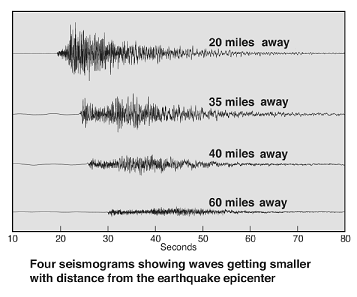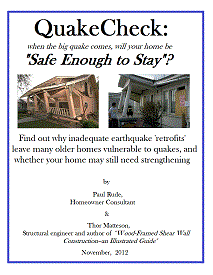
Want to see more detailed information on
earthquake retrofitting methods?
Check out this Indiegogo site to
sponsor a book on earthquake retrofitting
Or see the free download below:
Further Information on Earthquake Safety
(FEMA documents, other references)
Yes, you should be concerned about earthquakes
We hope you are reading this document because you already want to strengthen your home. In case you are not yet convinced, let us address the most common myths that people subscribe to about why their house may not need retrofitting."My house made it through the last earthquake with no damage”
In the San Francisco Bay Area, a disturbing number of people think that the 1989 Loma Prieta Earthquake, that was centered about 60 miles away, compares to a quake that might occur 60 yards away. The figure at top left shows how shaking intensity drops off dramatically as you go farther from the earthquake’s origin.The argument that “my house survived the Loma Prieta/ Northridge/ Nisqually/ fill-in-the-blank earthquake” might hold water if your house was at the epicenter of that quake. Otherwise you may as well add that your house survived Hurricane Sandy, the 2011 tornado season, the 1991 Oakland Hills Fire, and the eruption of Mount St. Helens. Don’t think you’re close to a fault? Many recent earthquakes occurred on faults that were previously unknown—including the 1983 Coalinga earthquake, the 1987 Whittier Narrows, 1994 Northridge, and 2003 San Simeon quakes.
“My house has withstood the test of time”
All buildings eventually fail the test of time. Time has allowed termites, carpenter ants, powder-post beetles, wood bees, and decay to weaken your structure. Tree roots have grown under and heaved the foundation. Gophers have burrowed back and forth under your footings and caused them to settle. Remodeling projects took out sections of walls to open the floor plan or add windows or doors. You replaced the light-weight wood shingles on the roof with new plywood overlain with concrete tile roofing.Earthquake faults are very patient as we are making our buildings heavier and weaker. In any one area, it may be centuries between earthquakes; ask the people in L’Aquila, Italy, some of whose buildings had stood for 900 years until a quake destroyed them in 2009. Older nations commonly experience earthquakes that destroy 400-year-old buildings, if for no other reason than earthquakes don’t occur very often. An earthquake in 1812 leveled New Madrid in Missouri and changed the course of the Mississippi River; if there had been more than 200 non-native settlers in the area at the time, this would have been a much more remembered event in our euro-centric history.
“My house was built to code”
Which code? Codes keep changing, for a couple of reasons: they don’t include all the requirements needed for good earthquake-resistant construction; and we keep learning more about how buildings react to earthquakes. For example, over the years, the foundation anchors required to secure the wood structure of your house to the foundation have increased in size and quantity. The connection requirement has roughly doubled in the last 20 years. If your house was built more than 20 years ago it may only have half of the anchorage that is considered adequate today.In some cases the current building code allows construction that immediately needs retrofitting to meet FEMA and other guidelines for earthquake resistance. In December, 2011, one of the authors submitted a code-change proposal to the International Code Council that clarifies current code requirements. The soonest that this could be adopted is 2015.
